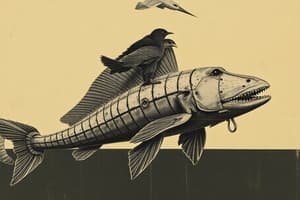Podcast
Questions and Answers
Which level of the classification hierarchy directly follows the kingdom level?
Which level of the classification hierarchy directly follows the kingdom level?
- Class
- Order
- Family
- Phylum (correct)
What is the correct full scientific name for human beings?
What is the correct full scientific name for human beings?
- Homo sapiens Linnaeus (correct)
- Homo sapiens
- Homo Linnaeus
- Hominidae sapiens
What does the term 'taxon' refer to in biological classification?
What does the term 'taxon' refer to in biological classification?
- The genetic makeup of an organism
- The process of naming organisms
- The level of classification below family
- A group of organisms classified together (correct)
Which of the following best describes the goal of classification?
Which of the following best describes the goal of classification?
Why is the binomial nomenclature system preferred over common names?
Why is the binomial nomenclature system preferred over common names?
What do the terms 'genus' and 'specific epithet' represent in the classification of a species?
What do the terms 'genus' and 'specific epithet' represent in the classification of a species?
Which statement about classification is true?
Which statement about classification is true?
What type of information can be used for classification?
What type of information can be used for classification?
What does systematics primarily study?
What does systematics primarily study?
Which statement accurately describes the difference between taxonomy and systematics?
Which statement accurately describes the difference between taxonomy and systematics?
What is a cladogram primarily used to depict?
What is a cladogram primarily used to depict?
Which group includes the last common ancestor plus all its descendants?
Which group includes the last common ancestor plus all its descendants?
What defines a polyphyletic group?
What defines a polyphyletic group?
What does phylogeny refer to?
What does phylogeny refer to?
How does taxonomy reflect phylogeny?
How does taxonomy reflect phylogeny?
Which of the following best describes ontogeny?
Which of the following best describes ontogeny?
What represents the largest classification category in the hierarchy of living things?
What represents the largest classification category in the hierarchy of living things?
Which classification includes organisms that are neither plants nor animals?
Which classification includes organisms that are neither plants nor animals?
Which feature is NOT associated with the classification of animal organization?
Which feature is NOT associated with the classification of animal organization?
What term refers to animals that possess three germ layers?
What term refers to animals that possess three germ layers?
Which term describes animals without a coelom?
Which term describes animals without a coelom?
Which category is the most specific in the classification hierarchy?
Which category is the most specific in the classification hierarchy?
Which group of organisms includes both multicellular and unicellular forms?
Which group of organisms includes both multicellular and unicellular forms?
What is a primary function of the coelom in animals?
What is a primary function of the coelom in animals?
What type of animal has no coelom and is described as acoelomate?
What type of animal has no coelom and is described as acoelomate?
Which of the following is an advantage of having a coelom?
Which of the following is an advantage of having a coelom?
What type of symmetry is defined as having body parts arranged without a central axis?
What type of symmetry is defined as having body parts arranged without a central axis?
In triploblastic coelomate forms, what surrounds the coelom?
In triploblastic coelomate forms, what surrounds the coelom?
What primary role does the coelom serve in triploblastic animals?
What primary role does the coelom serve in triploblastic animals?
What is a characteristic of bilateral symmetry?
What is a characteristic of bilateral symmetry?
Which of the following DOES NOT represent an advantage of having a coelom?
Which of the following DOES NOT represent an advantage of having a coelom?
Pseudocoelomates are characterized by which of the following features?
Pseudocoelomates are characterized by which of the following features?
What defines radial symmetry in animals?
What defines radial symmetry in animals?
Which group of animals are known to typically lack body symmetry?
Which group of animals are known to typically lack body symmetry?
Cephalization in invertebrates is important for which of the following reasons?
Cephalization in invertebrates is important for which of the following reasons?
Invertebrates can be classified as protostomes or deuterostomes based on what criterion?
Invertebrates can be classified as protostomes or deuterostomes based on what criterion?
Which characteristic is associated with segmentation in animals?
Which characteristic is associated with segmentation in animals?
Which of the following invertebrate groups exhibits external segmentation?
Which of the following invertebrate groups exhibits external segmentation?
Which of the following classifications does NOT represent a type of invertebrate?
Which of the following classifications does NOT represent a type of invertebrate?
What is the relationship between body symmetry and the presence of a nervous system in invertebrates?
What is the relationship between body symmetry and the presence of a nervous system in invertebrates?
Flashcards are hidden until you start studying
Study Notes
Important Terms
- Systematics: Study of organism diversity and the relationships among them.
- Taxonomy: Theory and practice of identifying, describing, naming, and classifying organisms.
- Phylogeny: Description of the evolutionary history of organisms, depicted through tree diagrams.
- Ontogeny: Developmental history of an organism.
- Cladogram: Diagram showcasing the relationships among organisms based on shared characteristics.
Evolutionary Groups
- Monophyletic Group: Contains the last common ancestor (LCA) and all its descendants.
- Polyphyletic Group: Contains descendants but excludes the LCA.
- Paraphyletic Group: Includes the LCA but does not contain all descendants.
Basic Classification Hierarchy
- Levels of classification include DOMAIN, KINGDOM, PHYLUM (DIVISION), CLASS, ORDER, FAMILY, GENUS, and SPECIES.
- Example: Human classification: Domain Eukarya, Kingdom Animalia, Phylum Chordata, Class Mammalia, Order Primate, Family Hominidae, Genus Homo, Species Homo sapiens.
Taxon / Taxa
- Taxon: A group of organisms in classification.
- There is no absolute way to determine classifications like genus or family, but consensus exists for groups such as green algae and bacteria.
The Species
- The only taxon with biological reality is the species.
- Scientific name structure: Genus + Specific Epithet = Species (e.g., Homo sapiens).
- Author citation for species naming is attributed to Linnaeus.
Classify / Classification
- Goal is a natural classification that serves as an information storage and retrieval system.
- Various data types can be utilized including morphology, anatomy, genetics, and behaviors.
Nomenclature
- Scientific naming system prevents confusion inherent in common names.
- Binomial nomenclature employs Latinized names with specific naming rules.
Classification Hierarchy
- Analogy of living things to a building:
- DOMAIN as a floor, KINGDOM as a large storage room, and cascading down to SPECIES as a single page.
Changing Classifications
- Classification systems vary (e.g., number of kingdoms debated: two, three, five, six).
- Various classifications for organisms such as Plantae, Animalia, Protista, Fungi, and Monera are noted.
Animal Organization: Features
- Features include segmentation, cephalization, coelom, germ layers, and symmetry patterns of early development.
Germ Layer
- Invertebrates can be classified as diploblastic (two germ layers) or triploblastic (three germ layers).
Coelom
- Types include acoelomates (no coelom), pseudocoelomates (false coelom), and coelomates (true coelom).
- Coelom allows for compartmentalization of organ systems, facilitating nutrient transport and disposal of waste.
Symmetry
- Asymmetry: No central axis.
- Bilateral Symmetry: Divided into right and left mirror images.
- Radial Symmetry: Divided into mirror images in multiple planes.
- All invertebrates, except sponges, exhibit some symmetry.
Cephalization
- Invertebrates with cephalization have advanced responses to their environment.
Early Development
- Invertebrates are classified as either protostomes or deuterostomes based on the fate of the blastopore.
Segmentation
- Seen in annelids and arthropods, external segmentation divides the body into repeating parts or segments.
Animal Phylogeny
- Main phyla include Echinodermata, Chordata, Arthropoda, Annelida, Mollusca, Nematoda, Platyhelminthes, Cnidaria, and Porifera.
Next Topic
- A survey of the animal kingdom will follow this introductory discussion on animal taxonomy, phylogeny, and organization.
Studying That Suits You
Use AI to generate personalized quizzes and flashcards to suit your learning preferences.




